 |
 |
 |
| |
Low rate of viral load rebound observed among treatment-naive genotype 1 patients with chronic hepatitis C treated with danoprevir (RG7227) plus Peg-IFN α-2a (40KD) (PEG ASYS) plus ribavirin: interim analysis
|
| |
| |
Reported by Jules Levin
AASLD Nov 2 Boston
S. Le Pogam,1 M. Chhabra,1 J.M. Yan,1 M.J. Ilnicka,1 Y. Ji,1 D.J. Chin,2 N. Gonzaludo,1 K. Klumpp,1 I. Najera1
1Roche, Palo Alto, CA, United States; 2Roche, Nutley, NJ, United States
Conclusions
This analysis shows that the incidence of viral load rebound (3.1%) or partial response (1%) is low in patients receiving treatment with danoprevir at dosages of 300 mg q8h or 600 mg q12h in combination with peginterferon alfa-2a (40KD) plus ribavirin. Neither viral load rebound nor partial response was observed in any patient treated with the higher dose of danoprevir (900 mg q12h) that completed the 12 weeks' treatment.
Viral load rebound was only observed in genotype 1a infected patients and was observed predominantly in Group A (5/6) [lower dose] with only one patient from dosing Group B.
Partial response was only observed in two genotype 1a patients from dosing Group B.
All cases of viral load rebound and partial response were associated with the emergence of the R155K mutant, and with reduced susceptibility to danoprevir.
R155K was not detected at baseline in any of these eight patients. However, four of the patients who experienced a viral load rebound did have variants (at low frequency) containing protease inhibitor resistance mutations V36A, T54A, A156T, or D168N/G. The lack of
enrichment for any of these variants shows that they were not associated with the viral load rebound or partial response observed in these danoprevir-treated patients.
Viral load rebound has not been observed to date in genotype 1b infected patients; this may be due to the higher genetic barrier of genotype 1b that requires two nucleotide substitutions to select for R155K (as opposed to one in genotype 1a).[8]
INTRODUCTION
Monotherapy with hepatitis C virus (HCV) NS3/4A serine protease inhibitors is associated with rapid viral load rebound associated with the development of resistance.[1]
When combined in triple therapy with peginterferon plus ribavirin, protease inhibitors have been shown to significantly increase SVR rates in genotype 1 patients, including both treatment-naive patients and previous non-responders to peginterferon plus ribavirin.[2-5]
Danoprevir (RG7227) is a potent, highly selective, oral inhibitor of the HCV NS3/4A serine protease which has been studied in combination with peginterferon alfa-2a (40KD) plus ribavirin, and in combination with the HCV polymerase inhibitor RG7128 in an interferon- and ribavirin-free combination regimen.[6,7]
Presently danoprevir at lower doses is also being studied in combination with ritonavir and peginterferon alfa-2a (40KD) plus
ribavirin to reduce danoprevir exposure whilst maintaining efficacy.
Unlike other HCV protease inhibitors, the resistance profile of danoprevir is largely restricted to one amino acid substitution in the NS3 protease sequence (R155K), as observed in 14-day monotherapy study.[8]
Patients participating in the ATLAS study were randomized to 12 weeks of treatment with danoprevir 300 mg q8h, 600 mg q12h or 900 mg q12h or matching placebo in combination with peginterferon alfa-2a (40KD) 180 µg/week plus ribavirin 1000/1200 mg/day, after which all patients continued treatment with peginterferon alfa-2a (40KD) plus ribavirin to complete a total of 24 or 48 weeks of therapy (Figure 1). In Group C the 900 mg q12h dose was stopped prematurely, with only eight patients completing 12 weeks of danoprevir.[6]
Objective
The aim of this study was to monitor and characterize the potential development of resistance to danoprevir during 12 weeks of triple combination therapy with peginterferon alfa-2a (40KD) plus ribavirin in treatment-naive HCV genotype 1 patients enrolled in the ATLAS study
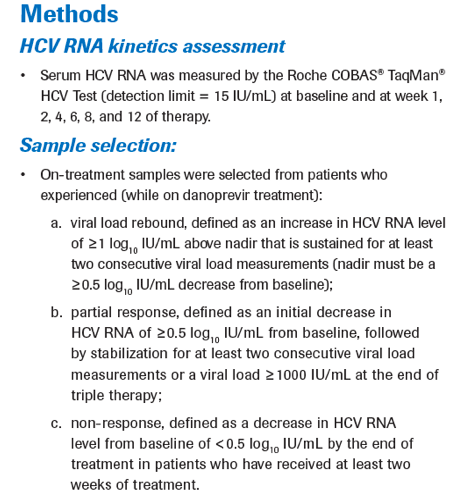
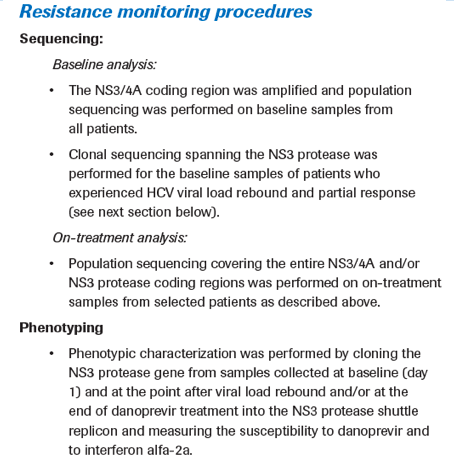
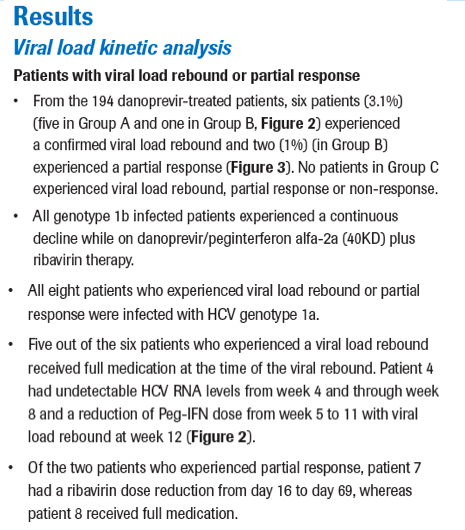

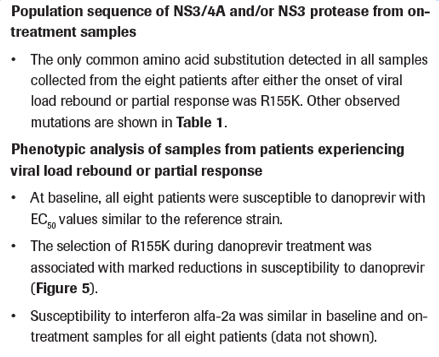
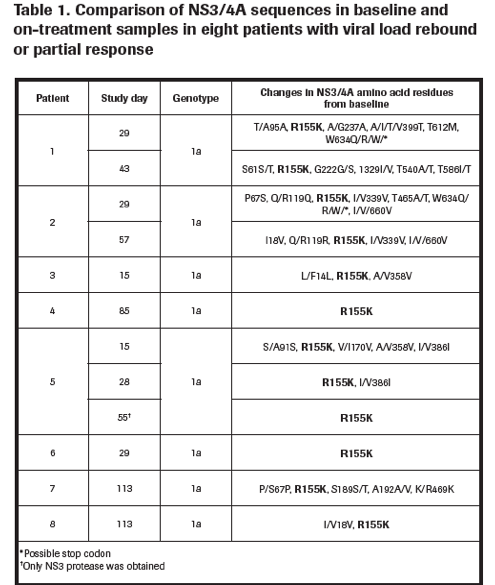
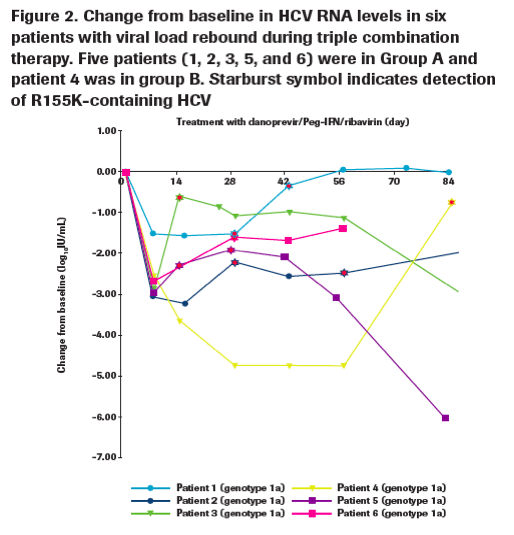
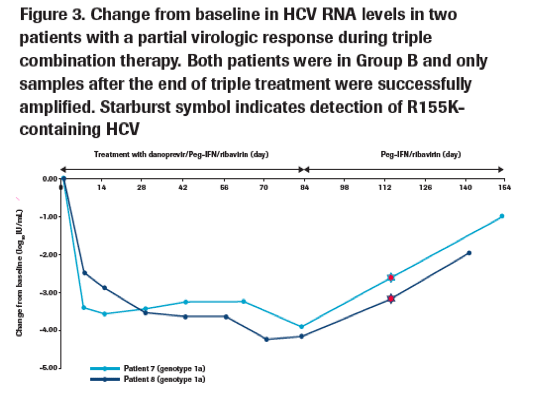
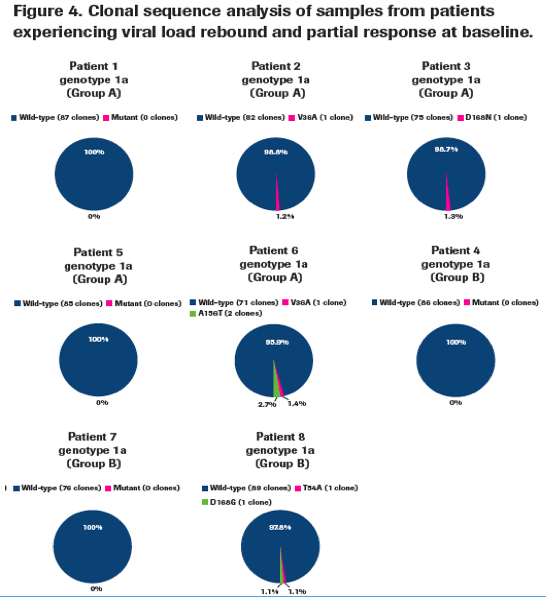
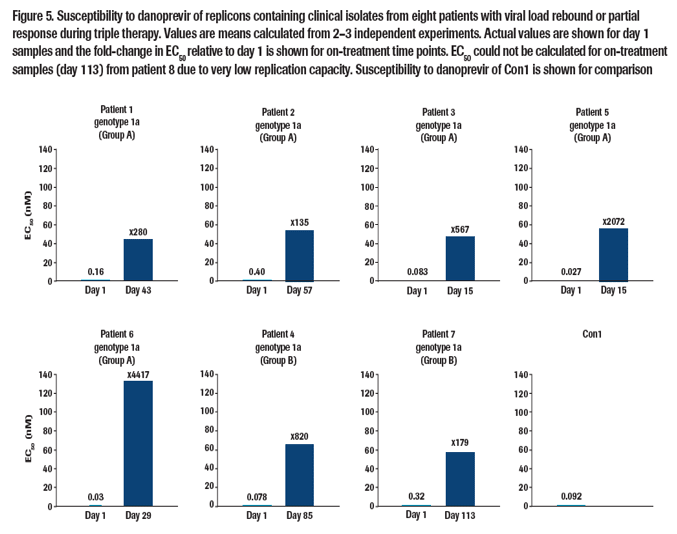
References
1. Forestier N, Reesink HW, Weegink CJ et al. Antiviral activity of telaprevir (VX-950) and peginterferon alfa-2a in patients with hepatitis C. Hepatology 2007; 46:640-8
2. Hezode C, Forestier N, Dusheiko G et al. Telaprevir and peginterferon with or without ribavirin for chronic HCV infection. N Engl J Med 2009; 360:1839-50
3. McHutchison JG, Everson GT, Gordon SC et al. Telaprevir with peginterferon and ribavirin for chronic HCV genotype 1 infection. N Engl J Med 2009; 360:1827-38
4. Kwo PY, Lawitz EJ, McCone J et al. Efficacy of boceprevir, an NS3 protease inhibitor, in combination with peginterferon alfa-2b and ribavirin in treatment-naive patients with genotype 1 hepatitis C infection (SPRINT-1): an open-label, randomised, multicentre phase 2 trial. Lancet 2010; 376:705-16.
5. McHutchison JG, Manns MP, Muir AJ et al. Telaprevir for previously treated chronic HCV infection. N Engl J Med 2010; 362:1292-303
6. Gane E, Roberts S, Stedman C et al. Oral combination therapy with a nucleoside polymerase inhibitor (RG7128) and danoprevir for chronic hepatitis C genotype 1 infection
(INFORM-1): a randomised, double-blind, placebo-controlled, dose-escalation trial. Lancet 2010; Published online, October 15, 2010.
7. Jensen D, Wedemeyer H, Herring R et al. High rates of early viral response, promising safety profile and lack of resistance-related breakthrough in HCV GT 1/4 patients treated with RG7128 plus Peg-IFN alfa-2a (40KD)/RBV: planned week 12 interim analysis from the PROPEL study. Oral presentation. The Liver Meeting 2010 [61st Annual Meeting of the American Association for the Study of Liver Diseases (AASLD)], October 29-November 2, 2010, Boston, MA, USA
8. Sarrazin C, Lim S, Qin X et al. Kinetic analysis of viral rebound and drug-resistant viral variant dynamics in patients treated with ITMN 191 (R7227) monotherapy suggests a high barrier to viral escape [abstract 1411]. Hepatology 2009; 50(Suppl. 4):953A
|
| |
|
 |
 |
|
|